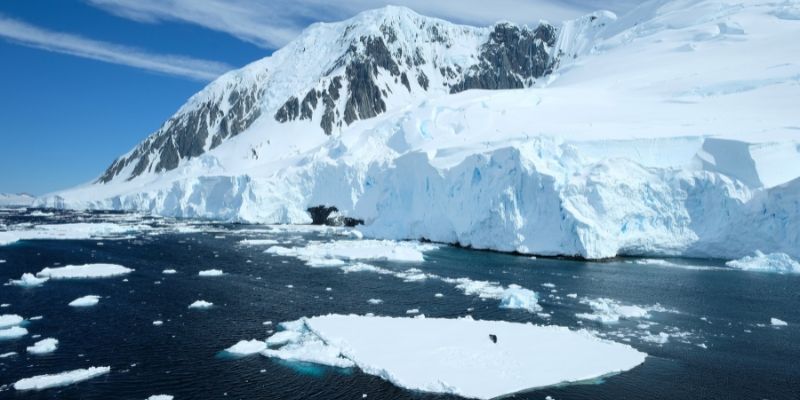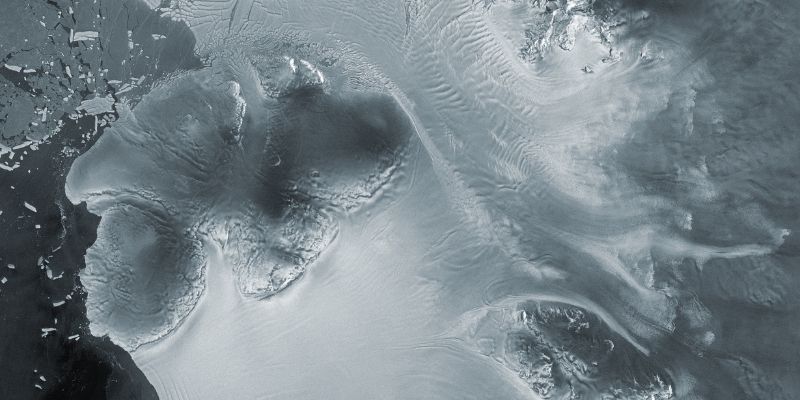
A glacier in Antarctica is committing “ice piracy” – stealing ice from a neighbour – in a phenomenon that has never been observed in such a short time frame, say scientists.
This activity was previously believed to take place over hundreds or even thousands of years.
However, high-resolution satellite observations reveal one huge glacier has been relentlessly pinching ice from its slower-moving neighbour over a period of less than 18 years.
University of Leeds researchers say it is unprecedented that this change in ice flow direction can be directly witnessed in Antarctica over such a short time span and its discovery is an important step in improving our understanding of the future of Antarctica and its contribution to sea level rise.
Their findings are published today (8 May) in the journal The Cryosphere.
A study, led by Leeds, shows the speeding up of seven ice streams in West Antarctica, with one almost doubling in speed (87%) at the boundary where the ice meets the ocean between 2005 and 2022, and three speeding up by between 60% and 84% during that time. Six of the streams reached average speeds of over 700 metres per year in 2022 – equivalent to advancing the length of seven football pitches in one year, a remarkably fast pace for ice.
The team used satellite data to measure the change in ice speed in the Pope, Smith and Kohler (PSK) region in West Antarctica.
“We didn’t know ice streams could ‘steal’ ice from each over such a short period, so this is a fascinating discovery.
They found the ice streams had sped up by 51% on average since 2005, at the grounding line - the point at which glaciers and ice shelves start to float. Grounding lines provide evidence of ice-sheet instability, because changes in their position reflect imbalance with the surrounding ocean and affect the flow of inland ice.
However, the research team found that one piece of data was particularly striking.
In stark contrast to the widespread acceleration observed between 2005 and 2022 on all other glaciers in the region, the ice stream on Kohler West slowed by 10%. The fastest rate of speed change was observed on its neighbour, Kohler East, as well as Smith West Glacier, which were flowing around 560 m/yr faster in 2022 compared to 2005.
Nowadays, several glaciers around Antarctica are responding to climate change by flowing faster into the ocean. When the flow of a glacier speeds up, its ice becomes more stretched and thins at the same time, yet the Kohler West ice stream has slowed down.
Lead author Dr Heather Selley, who undertook this work as a PhD researcher in the School of Earth and Environment at the University of Leeds, said: “We think that the observed slowdown on Kohler West Glacier is due to the redirection of ice flow towards its neighbour - Kohler East. This is due to the large change in Kohler West’s surface slope, likely caused by the vastly different thinning rates on its neighbouring glaciers.
“Because Kohler East’s ice stream is flowing and thinning faster as it travels, it absorbs, or “steals” ice from Kohler West.
“This is effectively an act of ‘ice piracy’, where ice flow is redirected from one glacier to another, and the accelerating glacier is essentially ‘thieving’ ice from its slowing neighbour.”
She added: “We didn’t know ice streams could ‘steal’ ice from each over such a short period, so this is a fascinating discovery.
“It’s unprecedented as we're seeing this from satellite data and it’s happening at a rate of under 18 years, whereas we’ve always thought it was this extremely long, slow process.”

Dotson Ice Shelf imaged by Sentinel-1. Credit: Contains modified Copernicus Sentinel data (2022), processed by ESA.
International collaboration
The team calculated the ice velocity using a tracking technique which measures the displacement of visible features at or near the ice surface, such as crevasses or rifts. Data on ice-thinning rates from the European Space Agency’s (ESA) CryoSat mission was also used in the study.
Leeds collaborated on the study with researchers from the British Antarctic Survey (BAS) and the UK Centre for Polar Observation and Modelling (CPOM) – which is led from Northumbria University – using data provided by satellites belonging to ESA, Japan Aerospace Exploration Agency, Canadian Space Agency and NASA.
Pierre Dutrieux, study co-author and climate researcher at BAS, said: “This study provides an interesting demonstration of ice piracy, where flow into one glacier gradually switches to flow into another glacier, as the ocean melts the grounding zone and re-configures ice flow.”
The team set out to establish mechanisms and impact of changes in conditions that impact how fast the ice flows, such as warming of the ocean, change in ocean circulation, change in air temperature and the amount of snow falling.
They found that redirection of ice flow and ‘piracy’ at previously unobserved rates has changed the amount of ice flowing into the floating shelves that are fed by these streams.
Crosson Ice Shelf, around 40 miles wide – roughly the distance from Leeds to Manchester – and Dotson Ice Shelf, around 30 miles wide – roughly the distance from Leeds to York – are two of the most rapidly changing outlets in West Antarctica, displaying both significant thinning and grounding-line retreat in recent decades.
Future effects
Professor Anna Hogg, study co-author and Professor of Earth Observation in the School of Earth and Environment at the University of Leeds, said: “The changes in flow direction have substantially altered the ice mass flux into Dotson and Crosson Ice Shelves, likely playing an important role in maintaining Dotson and accelerating the deterioration of Crosson.
“This suggests that ice flow redirection is an important new process in contemporary ice sheet dynamics, which is required to understand present-day structural change in glaciers and the future evolution of these systems.”
Over 410 million people could be at risk from rising sea levels by 2100 as a result of the climate crisis. Observed sea level rise data shows that global sea levels have already risen by more than 10 cm over the last decade.
Dr Martin Wearing, ESA Digital Twin Earth Scientist and Polar Science Cluster Coordinator, said: “This new study highlights the unique ability of satellites to provide both the temporal and spatial coverage required to assess change in the polar regions.
“Using data from Copernicus Sentinel-1 and ESA's Earth Explorer CryoSat, the team has revealed the complex evolution of ice flow in part of West Antarctica over the past few decades. Understanding these changing dynamics and what drives them is crucial for improved projections of future ice-sheet change and contributions to sea-level rise.”
The research was funded by UKRI Natural Environment Research Council (NERC), ESA and NASA Headquarters.
Further Information
The paper ‘Speed-up, slowdown, and redirection of ice flow on neighbouring ice streams in the Pope, Smith and Kohler region of West Antarctica’ is published in The Cryosphere on 8 May 2025.
Top image credit: BAS
For more information or to arrange interviews email Deb Newman via d.newman@leeds.ac.uk and copy in the press office via pressoffice@leeds.ac.uk.